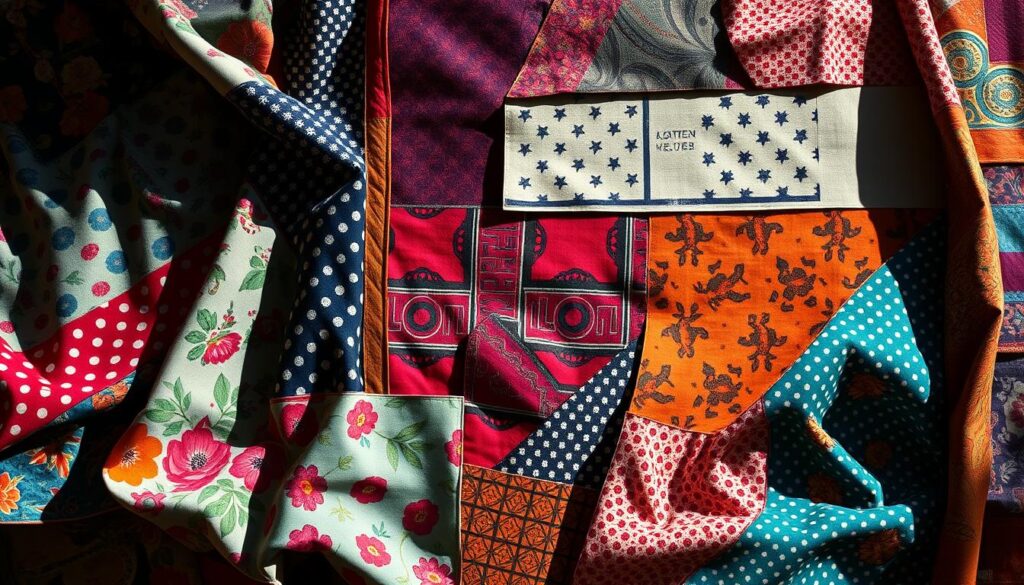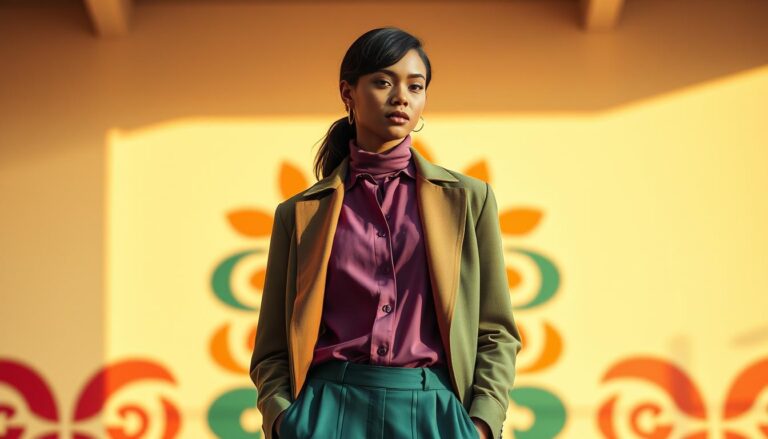Choosing the right colors for your clothes is key to a stylish wardrobe. It boosts your confidence and makes you look great. Knowing how to mix colors can change how you look and feel.
It might seem hard to pick the right colors, but it’s easier than you think. Simple tips can help you create outfits that show off your personality. Neutral colors like white, beige, and gray are great because they go well with many other colors.
Exploring color coordination can be fun. Most people think it greatly affects their style and how others see them. By sticking to a few colors, you can make outfits that are both stylish and easy to mix and match.
Key Takeaways
- Understanding how to choose colors for clothing is essential for creating a stylish and cohesive wardrobe.
- Applying effective clothing color selection tips can elevate your style and boost your confidence.
- Neutral colors can easily match with each other and can be combined with bright, soft, or primary colors.
- Not exceeding 3 colors in one outfit can help create a stylish and versatile wardrobe.
- 70% of individuals believe that color coordination significantly impacts their overall style and first impressions.
- Incorporating clothing color selection tips, such as using monochrome looks or classic contrasting color combinations, can create a stylish and cohesive wardrobe.
Understanding the Color Wheel
Color psychology in fashion starts with the color wheel. It’s a circle showing colors, with primary colors in the middle. To find the best colors for your skin, you must know how colors work together. The color wheel has twelve colors, including primary, secondary, and tertiary.
Primary colors are red, blue, and yellow. They are the base for all other colors. Secondary colors, like purple and green, come from mixing two primary colors. Tertiary colors, such as yellow-green, mix a primary with a secondary. Knowing the color wheel helps you pick colors that look good with your skin.
Warm colors, like red and yellow, bring energy. Cool colors, such as blue and green, bring calm. The 60-30-10 rule in color theory helps in fashion. It says 60% of your outfit should be one color, 30% another, and 10% an accent. This rule helps you pick the right colors for your skin and balance your outfit.
- Primary colors: red, blue, and yellow
- Secondary colors: purple, green, and orange
- Tertiary colors: yellow-green, blue-violet, and red-orange
- Warm colors: red, yellow, and orange
- Cool colors: blue, green, and purple
Using the color wheel and color psychology in fashion can help you build a wardrobe that suits your skin. Choose colors that highlight your face and use the 60-30-10 rule for a balanced look.
The Psychology of Color in Fashion
Choosing the right colors for your clothes can make a big difference. Colors like red can make you feel energetic and passionate. On the other hand, blue can bring calmness and serenity. By picking colors that match your skin tone and body shape, you can show off your personality and the occasion.
Wearing bright colors can boost your confidence and energy. Soft colors, on the other hand, can help you relax. This is why color coordinating outfits is key to a wardrobe that looks and feels great. Studies show that about 65% of people choose clothes based on color, showing how important it is to pick the right ones.
Here are some key points to consider when choosing clothing colors for your body shape and color coordinating outfits:
- Red is often associated with increased energy levels and enhanced physical performance, making it a popular choice for athletes.
- Blue is linked to feelings of calmness and serenity, with many individuals selecting it for job interviews to project trust and confidence.
- Yellow, associated with happiness and creativity, can uplift spirits and increase positive interactions.
Understanding color psychology can help you pick clothes that look good and make you feel great. Remember, choosing clothing colors for your body shape is not just about looks. It’s about feeling confident and energetic too. With the right colors, your fashion can reach new heights.
Skin Tone and Color Compatibility
Knowing your skin tone is key to a balanced wardrobe. In color theory for clothing, your skin undertone guides your wardrobe color palette selection. There are cool, warm, and neutral skin tones. Cool skin tones look great in blue-based colors, while warm skin tones shine in yellow-based colors.
Neutral skin tones can wear many colors. To find your skin undertone, check the color of your wrist veins. Blue or purple veins mean you’re cool. Green veins indicate a warm undertone. A mix means you’re neutral.
After figuring out your skin undertone, pick colors that flatter it. For cool undertones, try purples, greens, and deep blues. Warm undertones look good in brighter or darker colors than the middle.
Understanding your skin tone and color theory for clothing is crucial. By choosing the right colors, you boost your look and feel confident and stylish.
Creating a Versatile Color Palette
To build a capsule wardrobe, it’s key to pick colors that go well together. This means choosing colors that complement each other. Use the 60-30-10 rule to guide you: 60% of your outfit should be a main color, 30% a secondary, and 10% an accent.
Begin by picking 1-5 items from your closet that you love. Make sure to include at least one non-neutral color to add depth. For base colors, choose 2-3 that can be mixed and matched. Neutral colors like black, white, and gray are great because they go with many colors.
- Neutral colors like black, white, and gray
- Bold and bright colors that reflect your personality
- Earth tones like beige and navy
By using these colors, you can make a versatile wardrobe. Think about your skin and hair color when picking colors. Don’t be shy to try out different combinations to see what looks best on you.
Seasonal Color Trends
Understanding clothing color selection tips can help you update your wardrobe. Seasonal colors add a fresh look to your outfits. Color psychology in fashion is key, as colors can change how we feel.
Winter colors are darker and richer, while summer colors are brighter. Choosing colors that match the season’s mood is important. It’s also crucial to pick colors that suit your skin tone and style.
Here are some key seasonal color trends to consider:
- Winter: Darker, richer colors such as navy, black, and dark gray
- Summer: Brighter, more vibrant colors such as pastel pink, baby blue, and mint
By using these seasonal colors, you can create a stylish look for the season. Choose colors that look good on you and match your style. Don’t be afraid to try new clothing color selection tips to find what works best.
Pairing Colors for Effective Outfits
Creating outfits that look good together is key. It’s important to think about your skin tone and body shape. For example, cool skin tones shine in jewel tones like emerald and sapphire. Warm skin tones look best in earth tones like yellow and brown.
Choosing the right colors for your body shape matters too. If you have a cool skin tone, blue and white shoes work well. Warm skin tones can rock orange and yellow together. Classic combos like red, yellow, and blue are bold. Grey and navy are sophisticated.
Here are some tips for pairing colors:
- Use the 60-30-10 Rule: 60% of a dominant color, 30% of a secondary color, and 10% of an accent color for balanced outfits.
- Consider the color wheel: Colors that are opposite each other on the color wheel, such as blue and orange, can create a bold and eye-catching combination.
- Don’t be afraid to experiment: Try pairing different colors and see what works best for you.

By following these tips and considering your skin tone and body shape, you can create outfits that are both stylish and harmonious. Remember, the key to pairing colors effectively is to have fun and experiment with different combinations.
The Role of Neutrals in Your Wardrobe
Neutral colors like black, white, gray, beige, and navy are key for a versatile wardrobe. They help in color coordinating outfits and pair well with many colors. Knowing color theory for clothing helps you use these neutrals effectively.
A neutral color wardrobe can give you 37 different outfits. Focus on classic shades and add patterns and textures for variety. These colors are also easy to find in many styles and sizes, making them great for building a cohesive wardrobe.
These colors work well with bold colors for a statement look or alone for a sleek outfit. Adding neutrals to your wardrobe lets you create many color coordinating outfits for any event.
To pair neutrals with bold colors, use the 60-30-10 rule. Choose a neutral as the main color, a bold color as the secondary, and an accent color for a pop. This way, you get a balanced outfit that shows off your style and color theory for clothing knowledge.
Accessories: Adding Color Accents
Accessories can add a lot of personality to your outfits. Think about the psychology of colors and choose ones that show who you are and the event. For instance, bold accessories can make a statement by using complementary colors for clothing that stand out against your outfit.
Having a good wardrobe color palette selection can really change how you look and feel. To mix bright accessories with your clothes, pair them with neutral colors. Use the 60-30-10 rule to guide you: 60% of your outfit should be neutral, 30% a secondary color, and 10% an accent color.
Scarves, earrings, and bags are great for adding color to your outfits. A red aventurine earring can make a bold statement with a neutral outfit. Or, a tourmaline and diamond earring can add elegance. Try different complementary colors for clothing to find what works best for you.
Think about the season and the event when choosing accessories. For summer, light colors like blush pink are perfect. For fall, deeper colors like mustard yellow are great. The right accessories and wardrobe color palette selection can make your look stylish and unified.
Experimenting with Prints and Patterns
Mixing prints and patterns can add excitement to your outfits. Pair a bold print with a subtle one. Use similar colors to make it easier. For example, a striped shirt goes well with a floral or animal print.
When mixing prints, start with a neutral base. Mix different scales and find a common color. Accessories like scarves or belts can add a pop of contrast.

Fashion experts say 60% of people feel more confident in mixed print outfits. 75% think accessories are a safe way to try new print combinations. By experimenting, you can create outfits that show off your style with confidence.
Some favorite print mixes include:
- Floral and stripes
- Animal prints and polka dots
- Geometric shapes and solids
The secret to mixing prints is balance. Have fun trying different combinations to find what works for you.
Practical Tips for Color Coordination
Mastering color coordination is crucial for enhancing your fashion sense. Understanding the color wheel and following simple rules can help. This way, you can create outfits that show off your style and suit your skin tone.
Start by learning about primary, secondary, and tertiary colors. Also, know the difference between warm and cool hues. This knowledge is essential for choosing the right colors.
Color psychology in fashion can also influence your choices. Certain colors can make you feel certain ways. Try mixing colors like analogous shades for harmony or complementary colors for bold contrast.
Use neutral tones as the base of your outfit. Then, add accent colors to make it pop. This balance is key to a great look.
When building your wardrobe, try the 60-30-10 rule. This means 60% of your outfit is a main color, 30% is a secondary color, and 10% is an accent. This rule helps create a balanced and appealing outfit.
For inspiration, check out fashion magazines, blogs, and online color palette generators. They offer endless ideas for your color coordination journey.

